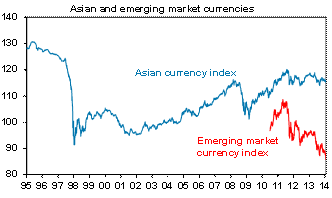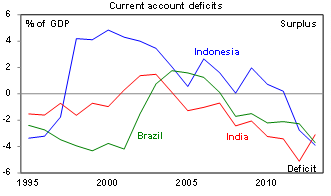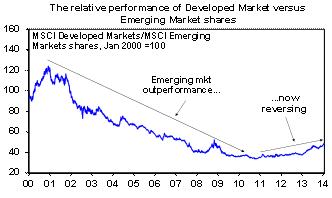Key points
- Concerns about emerging countries on the back of various political problems and trade imbalances that leave them vulnerable as the Fed slows down its monetary stimulus appear to have triggered a correction in share markets.
- However, while it makes sense to be cautious about emerging market shares generally, a re-run of the 1997-98 Asian crisis is unlikely and emerging markets are unlikely to pose a major threat to global economic recovery.
Introduction
The past week has seen renewed concerns about the emerging world reflecting a combination of political problems in several countries including Turkey and the Ukraine, a currency devaluation in Argentina and ongoing concerns about Chinese growth. Such concerns also reflect the impact of the Fed slowing its monetary stimulus at a time when parts of the emerging world are vulnerable.
This has seen falls in emerging market shares and currencies. Moreover, fears about exposure to the emerging world and a possible threat to global growth have seen share markets in advanced countries fall nearly 4% over the last week. Concern has returned that we may see a re-run of the 1997-98 “Asian-emerging markets crisis”.
Our assessment remains that another “Asian-emerging markets crisis” is unlikely. However, it is even clearer that the secular cycle has now turned against emerging market shares (EMs) relative to developed markets (DMs).
The 1997-98 Asian/emerging market crisis
Economic history reminds us repeatedly about the prevalence of cycles – both short term and long term. Asian and emerging countries and shares are not immune having gone in and out of favour several times over the last few decades. In the mid 1990s there was much talk of an “Asian miracle”. Growth was thought to be assured by high savings and investment rates, strong export growth and a shift in labour from rural areas to cities. However, as is often the case during good times, excesses set in including a growing reliance on foreign capital, current account deficits, excessive debt levels and over-valued fixed exchange rates. Eventually foreign investors had doubts. In mid-1997 Thailand experienced capital outflows that became a torrent and triggered a collapse in its fixed currency, which then led investors to search for countries with similar vulnerabilities (so-called “Asian contagion”) which led to the crisis spreading across the emerging world ultimately contributing to Russia’s debt default of 1998 that briefly dragged down developed market shares in August 1998.
In the 2000s, Asian and emerging countries mostly got their act together thanks to a range of productivity enhancing reforms, less reliance on foreign capital, low and floating exchange rates and high foreign exchange reserves and this along with the industrialisation of China and a related surge in commodity prices (which benefited South American countries and Russia) saw their growth rates improve. The enhanced perception of emerging countries and a secular slump in the traditional advanced economies of the US, Europe and Japan at the same time saw them once more come into favour amongst investors.
This reached a crescendo after the global financial crisis with talk of a “new normal” of poor growth in advanced countries and their rounds of quantitative easing encouraging capital flows to the “stronger” emerging markets leading in fact to talk of “currency wars” as EM currencies rose. The surge in the value of Asian currencies versus the $US over the last decade as a result of strong capital inflows can be seen in the next chart. Recent weakness has only reversed a small portion of the rally from Asian crisis lows, but emerging market currencies generally have been a lot weaker, having been in a down trend since 2011 (just like the $A!).

Back to the future?
Has Asia and the emerging world just gone full circle such that it’s now standing on the precipice once more? Several factors are driving current worries:
- Fed tapering has led to fears of a reversal in the money flow to the emerging world that may have come from quantitative easing. Transitions in Fed monetary policy often have implications beyond the US, eg the Mexican crisis when the Fed moved to tighten in 1994.
- This has occurred at a time when the flow of news in developed countries – the US, Europe and Japan - has continued to improve.
- Some emerging countries face political problems – the Ukraine, Turkey, Argentina and Thailand.
- Several emerging countries, notably Brazil, India and Indonesia, used the capital inflows that occurred as a result of quantitative easing in the US to finance budget and current account deficits.
- Slower growth in China has taken its toll on the emerging world generally by putting downwards pressure on commodity prices and dragging on the demand for imports from the Asian region.
- More fundamentally, the boom years of the last decade allowed several emerging countries to go easy on necessary structural reforms. Poor infrastructure, excessive regulation and restrictive labour laws are key problems. The end result has been inflation and trade imbalances and reduced potential growth rates.
The end result has been for investors to start rethinking the outlook for emerging countries with flows heading back to the advanced countries. The problem for emerging countries in raising their interest rates to support their currencies – as has occurred in several including Brazil, India and Indonesia – is that it further serves to slow economic growth making the investment outlook in such countries even less enticing.
Put simply, there is no easy way out for countries with current account deficits when foreign investors start to withdraw their capital. In the short term domestic spending must fall, interest rates must rise and exchange rates fall to bring this about. The only way to sustained stronger long term growth is to reform their economies, but that takes time.
Still not 1997, but the risks have increased
The next table compares the state of current account deficits & inflation today with the situation before the 1997-98 crisis.
Not as vulnerable as in 1997
| Current account, %GDP | FX reserves, $USbn | Inflation rate, % | ||||
| 1996 | Now | 1997 | Now | 1996 | Now | |
| Indonesia | -3.2 | -3.9 | 17 | 99 | 7.9 | 8.4 |
| Thailand | -7.9 | -1.6 | 27 | 167 | 5.9 | 2.2 |
| India | -1.6 | -3.1 | 20 | 295 | 9.0 | 9.9 |
| Korea | -4.4 | 4.6 | 20 | 345 | 5.1 | 1.1 |
| Taiwan | 3.9 | 10.0 | 84 | 421 | 3.1 | 0.3 |
| Malaysia | -4.4 | 5.0 | 15 | 136 | 3.5 | 2.9 |
| Singapore | 13.8 | 18.5 | 73 | 272 | 1.1 | 2.6 |
| HK | 3.9 | 2.3 | 93 | 309 | 5.9 | 4.3 |
| China | 0.9 | 1.9 | 140 | 3726 | 8.3 | 2.5 |
| Brazil | -2.7 | -3.7 | 58 | 376 | 9.6 | 5.9 |
| Russia | 2.8 | 2.3 | 25 | 524 | 21.8 | 6.4 |
Source: IMF, Bloomberg, AMP Capital
The overall position of emerging countries remains stronger today. Current account balances are generally in better shape, central banks have much higher foreign exchange reserves, exchange rates are floating rather than fixed and not as high as they were before the Asian crisis and inflation is lower. Having mostly floating rather than fixed exchange rates is a big distinction today because, as IMF research has confirmed, floating exchange rates are less prone to crises than fixed: they create less economic distortions and don't need to be defended from speculative attacks.

Source: IMF, AMP Capital
However, several countries are vulnerable, particularly Brazil, India and Indonesia where current accounts have moved heavily into deficit indicating a now heavy reliance on foreign capital inflows. See the previous chart.
Other emerging markets that are vulnerable thanks to current account deficits and hence a reliance on foreign capital inflows are the Ukraine, Turkey, South Africa and Chile.
By contrast China, South Korea, Taiwan and Russia with large current account surpluses are far less vulnerable.
While we don’t see a re-run of the Asian-emerging market crisis or a sharp collapse in emerging market growth the risks have clearly increased particularly for countries that now have large current account deficits. Emerging market growth generally is likely to be softer in the years ahead than what we got used to last decade.
Implications for investors
There are several implications for investors:
First, while emerging market shares are relatively cheap (with forward price to earnings multiples of around 10 times compared to 14 times for global shares) it’s too early to strategically reweight towards them. Notwithstanding likely bounces in relative performance along the way, the secular underperformance by emerging market shares relative to developed market shares could have a fair way to go yet, particularly given the extent of outperformance last decade.

Second, investors in emerging markets should focus on current account surplus countries as these are less vulnerable to foreign capital flows, eg China and Korea. And in any case Chinese shares are amongst the cheapest in the emerging world.
Thirdly, emerging markets are unlikely to pose a severe threat to growth in advanced countries. Yes the emerging market share of world GDP is now just over 50% compared to around 35% in the mid-1990s, but more fundamentally a sharp slump in emerging market growth is unlikely given the stronger position of many emerging countries today compared to that prior to the Asian-Emerging Market crisis.
Fourthly, emerging market worries appear to have provided the trigger for a correction in advanced country share markets that high levels of investor sentiment had left them vulnerable to. But once investor sentiment falls back to more normal levels the rally in shares is likely to resume.
Finally, while a recession in emerging market countries is unlikely, slower growth than seen over the last decade will act as a bit of a constraint on commodity demand, providing another reason why the broad trend in the Australian dollar will likely remain down. Ultimately I still see the $A heading down to $US0.80.
Dr Shane Oliver
Head of Investment Strategy and Chief Economist AMP Capital
DISCLAIMER: The above information is commentary only (i.e. our general thoughts). It is not intended to be, nor should it be construed as, investment advice. To the extent permitted by law, no liability is accepted for any loss or damage as a result of any reliance on this information. Before making any investment decision you need to consider (with your financial adviser) your particular investment needs, objectives and circumstances.
